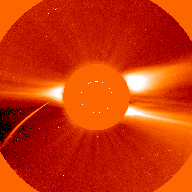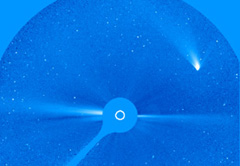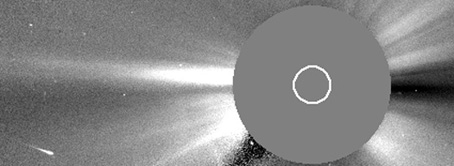|
As discussed on the eclipse primer page, total solar eclipses provide unique opportunities for the ground-based observation of comets near the sun. During recent years spacecraft such as the Solar and Heliospheric Observatory (SOHO) have detected numerous such objects whose existence would not have otherwise been known. Most of the comets detected by SOHO have been what are known as "Kreutz sungrazers," which are comets that come extremely close to the sun (within one million km) and which all travel on very similar orbits to each other; they are believed to be the fragments of one giant comet that split up thousands of years ago. Some Kreutz sungrazers have been among the brightest comets ever seen, for example, Comet Ikeya-Seki in 1965, which briefly became bright enough to be seen during daylight. The Kreutz sungrazers detected by SOHO, however, have been much smaller than this, and all of them seem to have disintegrated as they approached the sun. The SOHO image to the right shows comet C/1996 Y1, the brightest Kreutz sungrazer SOHO has so far detected. |
|
|
|
At this writing (September 1999) SOHO has detected over 80 Kreutz sungrazers. In addition to these, SOHO has detected eight other comets which are not members of this famous comet "family." Three of these were already-known comets which SOHO observed as they were passing near the sun; by far the brightest of these was Comet Hyakutake C/1996 B2 (shown in the SOHO image below left), which during the previous six weeks had been a spectacular object as seen from the northern hemisphere. The other five comets were all new "discoveries" by SOHO; one of these (comet C/1998 J1) did become observable from the ground about two weeks after SOHO first detected it, whereas the other four were smaller objects which either disintegrated or which were simply too dim for ground-based detection once they had moved far enough away from the sun. The below right SOHO image shows one of these comets, C/1998 G3, which grew much dimmer and possibly disintegrated about two days after this image was taken.
These various SOHO images were provided courtesy of Doug Biesecker, who was one of the participants on the eclipse delegation to Iran. More information about the SOHO comets, especially the Kreutz sungrazers, can be found on his comet page.
|
|
|
|
During the eclipse I wanted to try to detect any comets that might be near the sun. Since Doug was in reasonably regular contact with his stay-at-home co-workers on the SOHO project, we would have any heads-up if there were indeed any comets that were close by. It was even slightly possible that we might "discover" a non-sungrazing comet, since the "outer" coronagraph (C3) on SOHO only images out to 8 degrees from the sun, and a bright comet located beyond (but not far beyond) this distance might still be too close to the sun to be detectable from the ground otherwise. My plan was to take photographs specifically covering the expected path of the Kreutz sungrazers, and to do visual searching (with binoculars) both along the sungrazer path and around the general vicinity of the sun.
Unfortunately, although the sky was clear during totality it was also unusually bright for a total eclipse (about the brightness level of early twilight). The bright sky (together with the short duration of totality, which was less than two minutes from our site) precluded any significantly detailed comet searches. I did perform the visual search program, but a comet would have had to have been very bright for me to have detected it; in fact, the only object I convincingly observed was the planet Venus. The photographs I took along the Kreutz sungrazer path were over-exposed in the bright sky and did not reveal anything
It turns out that SOHO detected a Kreutz sungrazer approximately two days before the eclipse, and another one approximately 12 hours after totality. Neither of these would have been visible during totality; the earlier one would have disintegrated by the time of the eclipse, and the latter one would have been too dim to detect even under the best of circumstances. There have been no reports of any other comets that might have been near the sun around the time of the eclipse.
Although this particular project was unsuccessful we nevertheless learned quite a few lessons about how to go about carrying out a search for comets, and we hope to be applying these during solar eclipses in the future.
|
|


